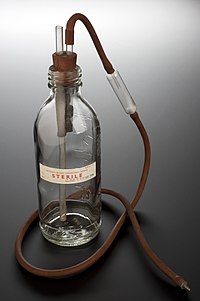Blood
The term blood reserve is the name for a specific cellular blood product , which mainly consists of erythrocytes (red blood cells). Other cellular blood products are platelet concentrates and granulocyte concentrates . In colloquial terms, this mostly only refers to the erythrocyte concentrate , as this is most often transferred or transfused. An erythrocyte concentrate is a tear-resistant, sterile and gas-permeable plastic bag ( polyvinyl chloride (PVC) ) filled with the red blood cells of a donor , which is used for the transfer ( transfusion ) of erythrocytes to a recipient.
Whole blood is very rarely used for blood transfusions . Instead, the blood is usually administered separately into its components. Glass containers were in use until the early 1970s.
Depending on the type, the bags contain around 300 ml of blood (components). The exact type, blood group , subgroups, blood formula and a unique canning number are noted several times on the canning bags and printed on removable labels to avoid copying errors. The can numbers are assigned according to the Eurocode standard (Eurocode IBLS, Eurocode International Blood Labeling System). This means that it is always possible to trace which canned food has been processed and issued by which institute.
Preservation
To preserve it, stabilizers are added to the blood, which increase the shelf life. The stabilizer solutions ACD-A (“Acid-Citrate-Dextrose” with adenine), CPD (“Citrate-Phosphate-Derivative”) or CPD-A (“Citrate-Phosphate-Derivative” with adenine) are described. Citrate suppresses blood coagulation , phosphate serves to stabilize the pH value , glucose functions as an energy supplier, adenine promotes the formation of adenosine triphosphate (ATP) in the red blood cells . The most commonly used stabilizer is the CPD-A solution. It contains 3 g citric acid, 26.3 g sodium citrate, 2.2 g sodium dihydrogen phosphate, 31.9 g glucose monohydrate and 0.275 g adenine, which are made up to 1 liter with 1000 ml of distilled water. The pH of this stabilizer solution is between 5.6 and 5.8; if 63–70 ml of it is mixed with 450 ml of blood, the resulting pH value of the can is 7.1–7.2. This is very important for the storage of the red cell concentrates at +2 to +6 ° C.
All types of canned food must be kept refrigerated. Fresh plasma concentrates are even frozen. You will be brought to room or body temperature before the transfusion .
Shelf life of a stored blood unit
In the preparation described above, the red cell concentrate has been made stable for 35 to 42 days at a storage temperature of 2-6 ° C.
Test for infectious agents
Since October 1985 it has been a legal requirement in Germany to carry out an HIV antibody test for blood in addition to numerous other tests .
See also
- blood donation
- Blood bank
- Patient Blood Management
- Infections from blood products contaminated with HIV
Web links
- The same applies to blood: the fresher, the better. On: Wissenschaft.de from June 26, 2006
Individual evidence
- ↑ eurocode.org
- ↑ K. Hardtke et al. (Ed.): Commentary on the European Pharmacopoeia Ph. Eur. 7.0, stabilizer solutions for blood products. Loose-leaf collection, 39th delivery 2011, Wissenschaftliche Verlagsgesellschaft Stuttgart.
- ↑ "Anticoagulant Citrate Phosphate Dextrose Adenine Solution", United States Pharmacopeia 36.

